2023年9月6日,南方科技大学物理系、粤港澳大湾区量子科学中心林君浩副教授课题组与南京大学物理学院、固体微结构国家重点实验室高力波教授课题组合作,在二维范德华超导异质结的晶圆级生长及其机理研究方面取得突破性进展,相关研究成果以《晶圆级范德华超导异质结的堆叠生长》(Stack growth of wafer-scale van der Waals superconductor heterostructures)为题发表在国际顶级期刊《自然》(Nature)上。南科大物理系研究助理教授侯福臣作为论文共同第一作者,承担了研究多层vdWSH中元素分布和堆叠结构的原子级扫描透射电镜(STEM)表征的工作,物理系2019级博士研究生王刚作为重要合作者,承担了部分研究原子级STEM结构表征的工作。
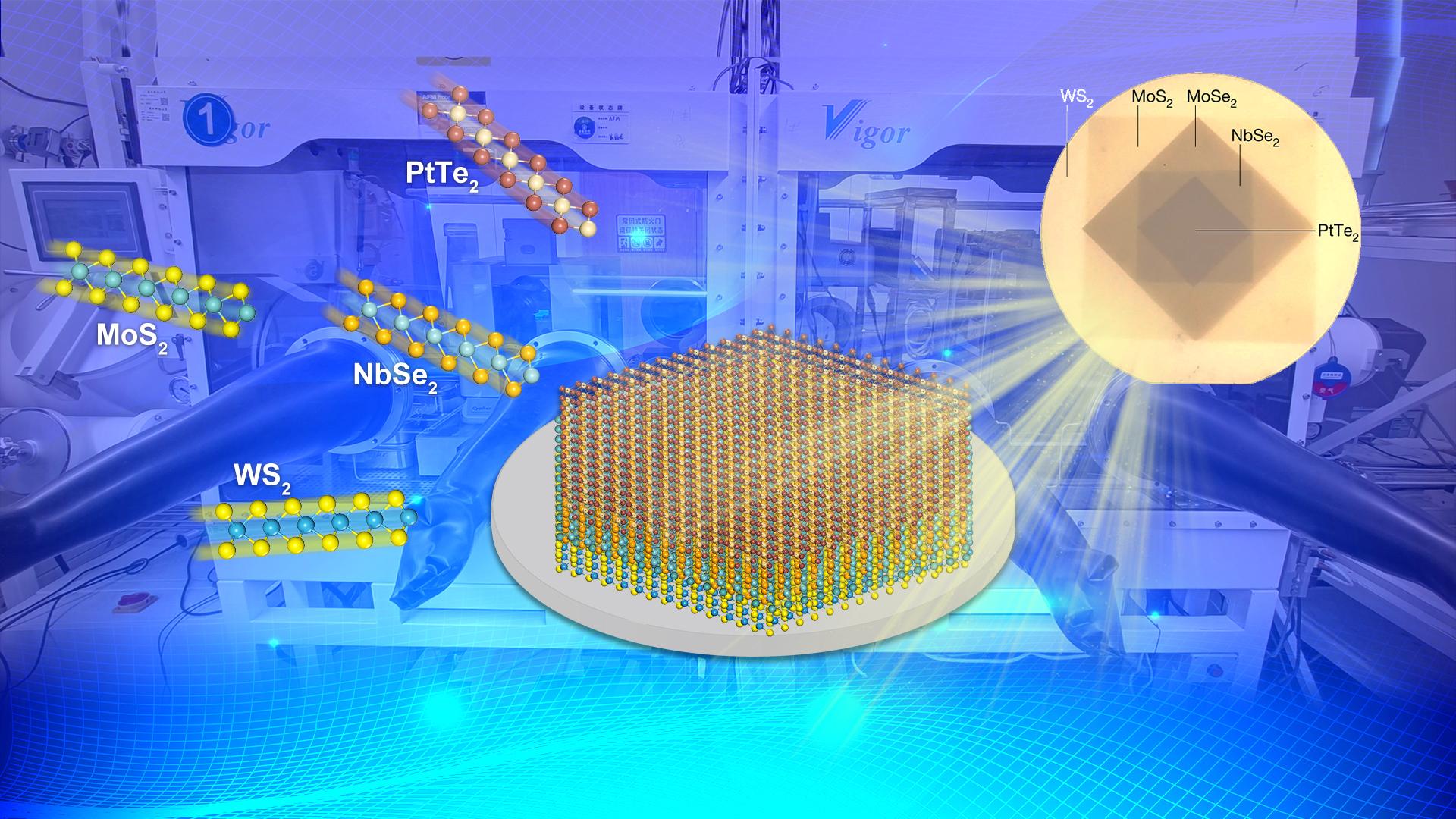 二维超导异质结中的二维超导材料层,如NbSe2等,由于结构不稳定,很难在二维异质结中直接通过生长集成,因而成为二维范德华超导异质结大规模制备的关键难题。为了克服这个问题,合作团队开发出了一种全新的“高温到低温”的逐层生长策略(图1),通过巧妙设计二维异质结中每一层的生长环境,使其生长温度均低于前序层,从而实现了高质量的可控多层范德华超导异质结(vdWSH)晶圆级生长。该方法能够精确地控制vdWSHs中二维超导体材料的层数,并通过球差电镜表征证实了多层体系的高质量堆叠结构。
二维超导异质结中的二维超导材料层,如NbSe2等,由于结构不稳定,很难在二维异质结中直接通过生长集成,因而成为二维范德华超导异质结大规模制备的关键难题。为了克服这个问题,合作团队开发出了一种全新的“高温到低温”的逐层生长策略(图1),通过巧妙设计二维异质结中每一层的生长环境,使其生长温度均低于前序层,从而实现了高质量的可控多层范德华超导异质结(vdWSH)晶圆级生长。该方法能够精确地控制vdWSHs中二维超导体材料的层数,并通过球差电镜表征证实了多层体系的高质量堆叠结构。
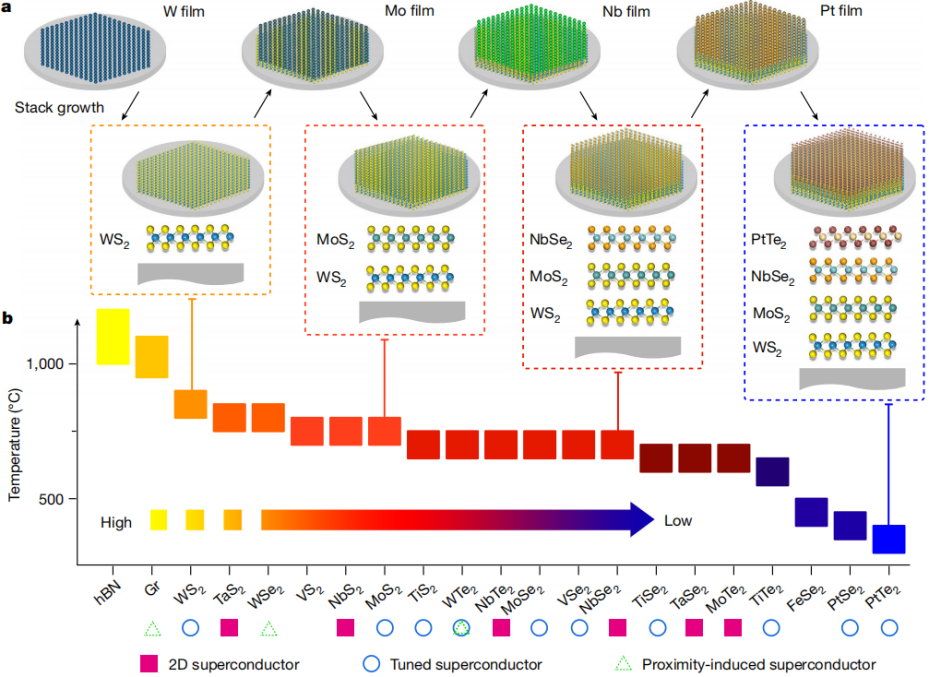
图1 高温到低温策略堆叠生长多层范德华超导异质结
二维范德华(vdW)异质结构被认为是探索二维物理和器件应用的最佳途径,其中,vdWSHs是由二维超导体与其他材料堆叠产生的,高质量的二维vdWSHs的制备为创建超导近邻效应、超导约瑟夫森结、超导二极管和基于马约拉纳零模能的量子计算提供了平台。然而,在实验室中,最广泛的制造方法是通过干法转移堆垛机械剥离的微米大小薄片来产生二维vdWSHs,但由于其产率低,失败率高,该方法只适合基础科学研究,无法进行实际的应用。二维vdW异质结的大规模制备一般采用化学合成法,但由于二维超导材料的结构敏感性,无法在多步生长法中得到质量较高的超导层材料,因此,目前几乎没有任何二维超导材料可以在晶圆级尺寸下完整地堆叠成vdW异质结构,这极大地限制了此类器件的应用。
在此工作中,研究团队合作报道了一种“高温到低温”的逐层生长策略。该策略在合成二维vdW异质结构方面做了一些巧妙的设计:一方面,该生长策略采用多循环的两步气相沉积工艺,在每层二维材料的生长中均使其生长温度低于其前序材料,可以很好地避免当前晶体层在多循环生长过程中由于温度过高造成的晶体劣化,从而在晶圆尺度上实现特定的vdWSH薄膜制备(图2);另一方面,采用逐层生长的多步策略能更好地保留二维材料晶体的高质量晶体结构、高环境稳定性和高热稳定性,使利用堆叠逐层生长制备出具有干净界面和完整超导性能的vdWSH薄膜成为可能。团队进一步通过调控温度,在双层到五层的二维vdW异质结上实现了49种不同堆叠结构组合的精确制造,并测量到了与块体材料一致的超导特性,这证明了该方法生长的二维超导层材料在多循环的异质结生长过程中仍然保留高质量晶体结构。
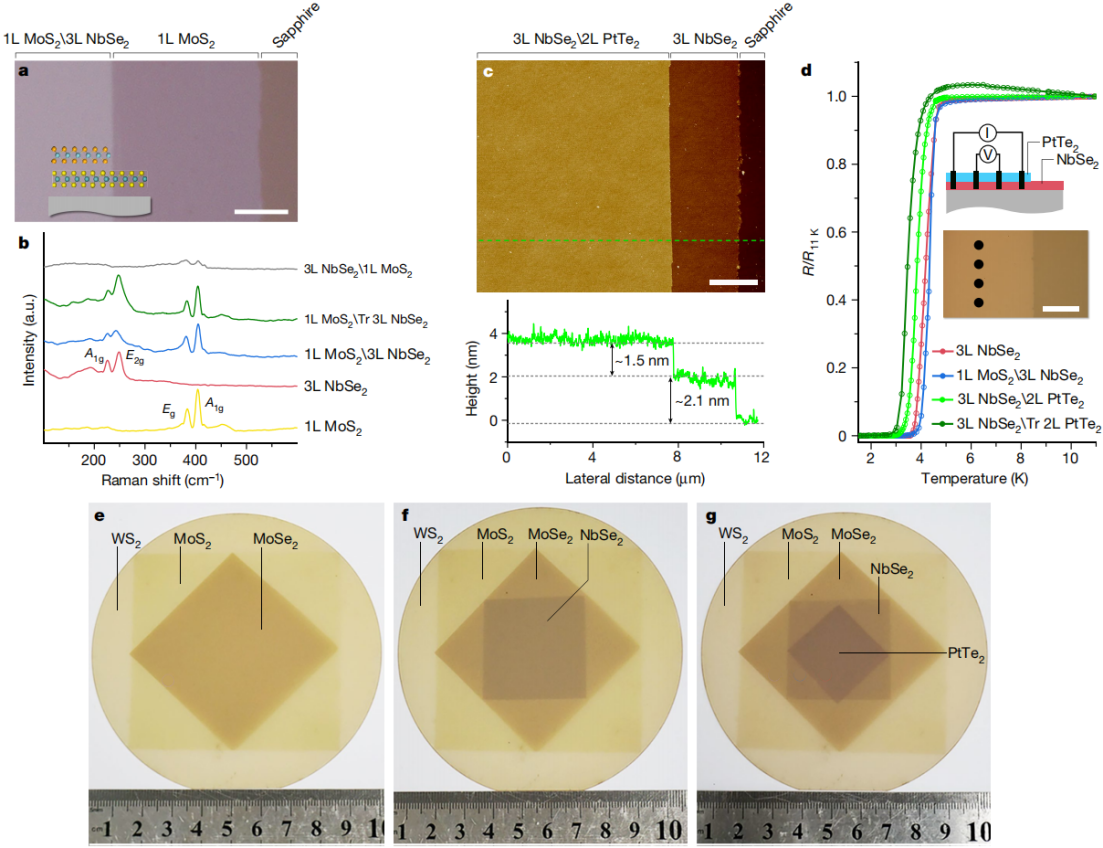
图2 “高温到低温”策略的普适性和晶圆级vdWSH薄膜的均匀性
二维超导材料具有较高的表面活性,容易被空气氧化并吸附环境中的碳氢化合物,严重制约着样品的表征和物性的测试。南科大林君浩副教授课题组自主搭建的全惰性氛围保护的手套箱互联系统(GIS)(图3)实现了从样品生长、转移、后处理、原子级结构表征到物性测试的全惰性氛围保护,极大地降低了二维敏感材料的氧化与污染,对于本次研究二维vdWSH薄膜异质结材料的本征结构与生长机理具有独特的优势。
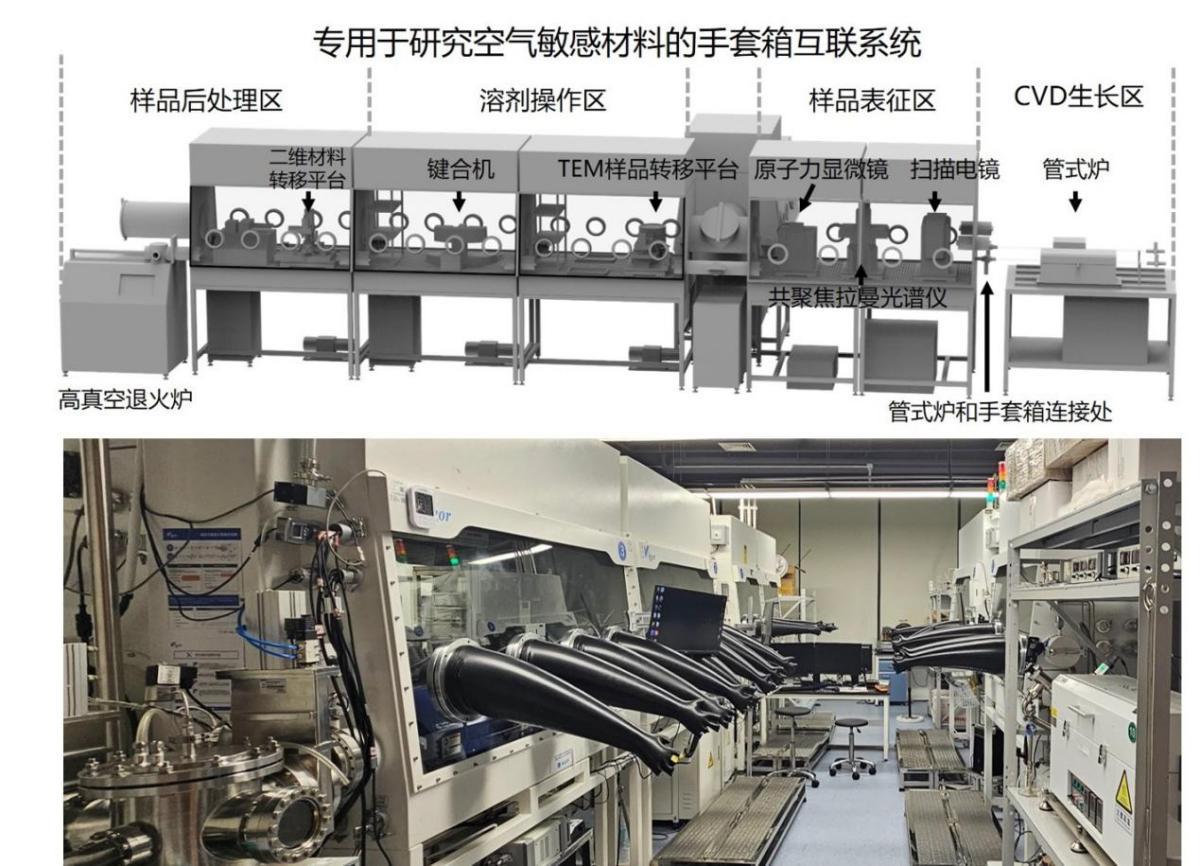
图3 手套箱互联系统示意图(上)和实物图(下)
研究团队将采用“高温到低温”堆叠策略生长的多层vdWSH薄膜方法与手套箱互联系统相结合,在不同视角下实现了对本征样品的逐层元素分布和原子级STEM结构表征。如图4所示,研究人员确认生长了具有不同层数和不同堆叠结构的异质结薄膜,并且通过EDS图谱证明了其中二维超导材料NbSe2层数的可控性(图4a-d)。使用这种生长策略,研究人员实现了高达26类双层、15类三层、5类四层以及3类五层的vdWSH薄膜。相应的原子分辨率扫描透射高角度环形暗场像(HAADF-STEM)显示:与直接在衬底上的生长制备技术相比,在WS2上生长的单层NbSe2要具有更少的缺陷密度,这一结果证明二维vdW异质堆垛结构具有很高的晶体质量。此外,结合快速傅里叶转换(FFT)发现,对于晶格不匹配的二维过渡族金属硫族材料的堆叠,会形成具有一定扭转角度的摩尔超晶格,并且随着晶格失配程度的改变,扭转角度也会发生改变。统计转角的结果表明,晶畴的拼接存在一定的角度依赖,但并不影响二维超导层材料的超导特性。这些实验证据表明“高温到低温”策略能够实现高质量的二维vdW异质结构的晶圆级生长,并具有良好的普适性。
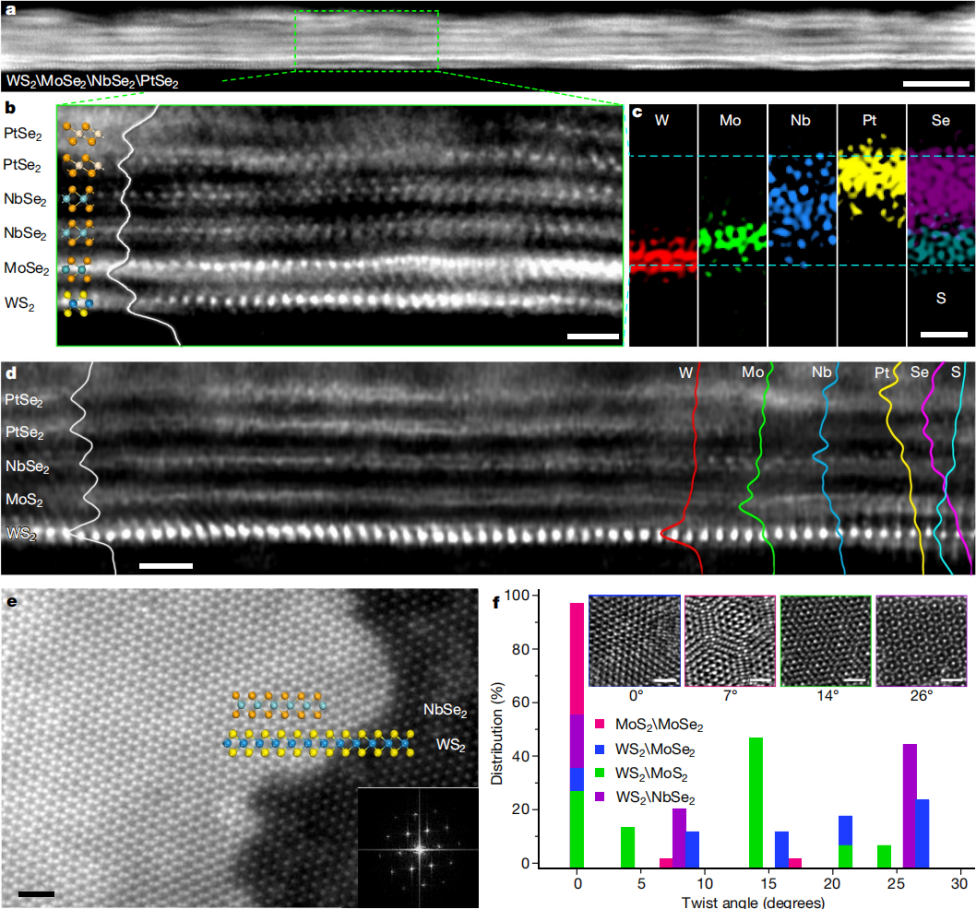
图4 多层vdWSH薄膜的晶体结构表征和元素分析
该工作提出了一种普适的“高温到低温”生长策略,在晶圆级尺度上实现了多层二维范德华超导异质结薄膜的生长,并且可以精确地控制薄膜的厚度和每一种材料的层数,堆叠生长的二维范德华超导异质结薄膜具有良好的晶体质量和较强的层间耦合,其中,与手套箱结合的原子结构表征结果在揭示薄膜生长机制和结晶程度方面起到了关键的作用。
南京大学博士生周振佳、南方科技大学物理系研究助理教授侯福臣为本论文的共同第一作者,南京大学高力波教授、徐洁副研究员和南方科技大学林君浩副教授为本论文的共同通讯作者。
该工作的开展和完成得到了国家重点研发计划项目、国家自然科学基金、中央高校基本科研基金、江苏省自然科学基金、中国福英通教育基金、国家创新人才博士后计划、广东省创新创业团队、深圳市高层次人才团队、深圳科技计划高校稳定支持等项目以及南方科技大学皮米中心和粤港澳大湾区(广东)量子科学中心的大力支持。
文章链接:https://www.nature.com/articles/s41586-023-06404-x